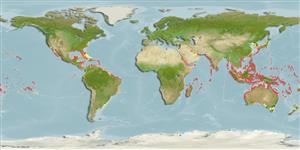Common names from other countries
Classification / Names / Names
Common names | Synonyms | Catalog of Fishes (gen., sp.) | ITIS | CoL | WoRMS
Environment: milieu / climate zone / depth range / distribution range
Ecology
Benthic; depth range 0 - 20 m (Ref. 348). Tropical
Indo-Pacific: East Africa to Red Sea and Polynesia.
Length at first maturity / Size / Weight / Age
Maturity: Lm ? range ? - ? cm Max length : 9.0 cm TL male/unsexed; (Ref. 348); common length : 7.0 cm TL male/unsexed; (Ref. 348)
Shell equivalve, thick and inflated, very inequilateral, posteriorly expanded. Shape somewhat irregular, elongate rectangular in outline, with strongly protruding umbones anteriorly and a broad rounded keel from umbones to posteroventral margin. Posterior margin obliquely truncate, ventral margin slightly sinuous with a well-developed byssal gape. Cardinal area wide and riblets crossed by irregular growth marks, and a few larger radial ribs on posterodorsal slope. Periostracum coarsely pilose, mainly persisting towards shell margins. Hinge straight very long and narrow. Internal margins smooth. Colour: Outside of shell often encrusted with marine growths; posterior half dark brown, anterior half creamy white with zebra-like brown stripes. Inner side more or less strongly tinged with dark brown.
Life cycle and mating behavior
Maturity | Reproduction | Spawning | Eggs | Fecundity | Larvae
Members of the class Bivalvia are mostly gonochoric, some are protandric hermaphrodites. Life cycle: Embryos develop into free-swimming trocophore larvae, succeeded by the bivalve veliger, resembling a miniature clam.
Poutiers, J.M. 1998. (Ref. 348)
IUCN Red List Status (Ref. 130435: Version 2024-1)
CITES status (Ref. 108899)
Not Evaluated
Not Evaluated
Threat to humans
Harmless
Human uses
Fisheries: commercial
| FishSource |
Tools
Internet sources
Estimates based on models
Preferred temperature
(Ref.
115969): 24.2 - 29.2, mean 28 (based on 4316 cells).
Resilience
Low, minimum population doubling time 4.5 - 14 years (K=0.06).
Vulnerability
Moderate to high vulnerability (46 of 100).
